
21 minute read
Would Sod Alternatives to Traditional Lawn Grasses Add to Your Market?
WOULD SOD ALTERNATIVES TO TRADITIONAL
LAWN GRASSES ADD TO YOUR MARKET?
By Suz Trusty
Editor’s note: The article on page 38 focusing on research for pollinator friendly lawns closed the sidebar with this statement, “Forward thinking companies will find a way to include ‘refuge lawns’ on stakeholder properties—and they’ll make money doing it.” That prompted your editors to harvest a few examples from past Turf News articles that highlight sod producers that have adopted sod alternatives to traditional grasses—and check in with those companies for an update on those products. We offer these as ideas to help spark your own research into innovative products that will add to your market.
Adopt the mindset of Eric Heuver, a past president of Turfgrass Producers International (TPI) and president of Eagle Lake Professional Landscape Supply in Strathmore, Alberta, Canada. Heuver says, “We strive to be solutionbased, which comes from listening to our customers and keying into the market. If the customer says, ‘I wish there was an easier way to do …’ that’s what we follow up on. Do we have a product, or can we come up with a product, to meet these needs?”
Alternative Products Are Thriving at Eagle Lake
Multiple innovations have been born from that mindset and several have evolved into viable products. Two of those are sod alternative ground cover solutions to traditional grasses. One is the Sedum Turf product, a new environmental ground cover, similar to the sedums used on green roofs. Sedum Turf is composed of a broad selection of sedum varieties grown outdoors at the Strathmore farm in a soil base on a biodegradable, coconut fiber erosion mat and plastic so that it is as easy to install as turfgrass sod.
Another alternative product was developed for a National Parks project that allowed no introduced vegetative species. Heuver developed a product similar to Sedum Turf, growing the specified native grasses on a coconut-based erosion control mat. That product is named NaturesTurf. It offers a wide variety of vegetation options including native and adaptive grasses, sedges, and forbs. The seed blends are hand selected to meet the aesthetics and functional requirements of each project. Although Eagle Lake grows some stock varieties, much of the NaturesTurf product is custom grown to meet specific project requirements. NaturesTurf is an ideal solution for areas which are difficult to vegetate with conventional methods and where specific or native varieties are required. Potential applications include storm pond perimeters, dry ponds, wetlands, park trail reclamation, areas with erosion control challenges, and sensitive areas requiring native plantings only. NaturesTurf gives immediate vegetation and erosion control once installed.
A related product Eagle Lake has introduced is a sandbag-size, biodegradable jute bag filled with custom engineered soil and a specific grass seed that can produce the desired vegetation in a high erosion area. Heuver says, “As we branch into new areas, we’re pulling from things we’re already doing well, such as selling soil and seed, and combining it with our knowledge of how to germinate grass. It’s working with our knowledge base, our equipment and infrastructure, and our personnel resources.”
Sedum Turf is an environmental groundcover grown as sod for specialty uses, such as this seating area. Photo courtesy of Eagle Lake Landscape Supply Sedum Turf is grown as sod to quickly establish in landscaping situations such as the edge of this path. Photo courtesy of Eagle Lake Landscape Supply
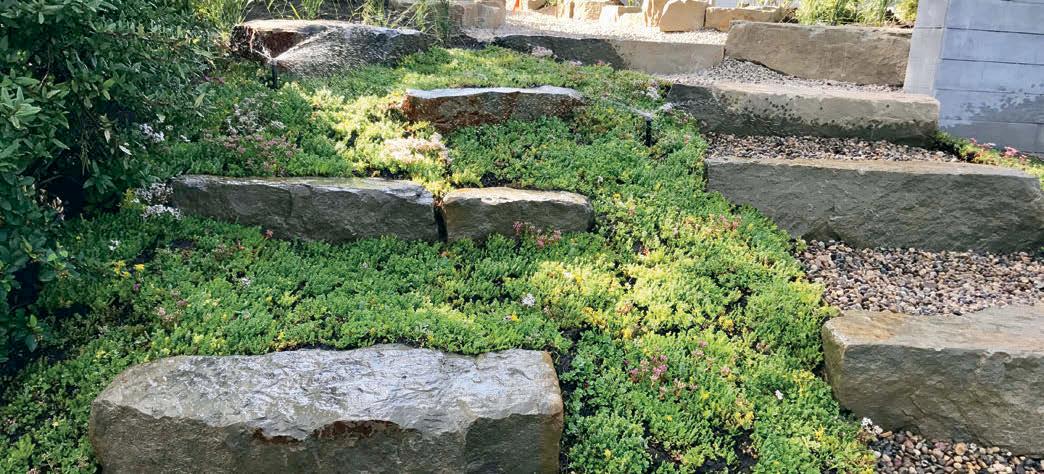
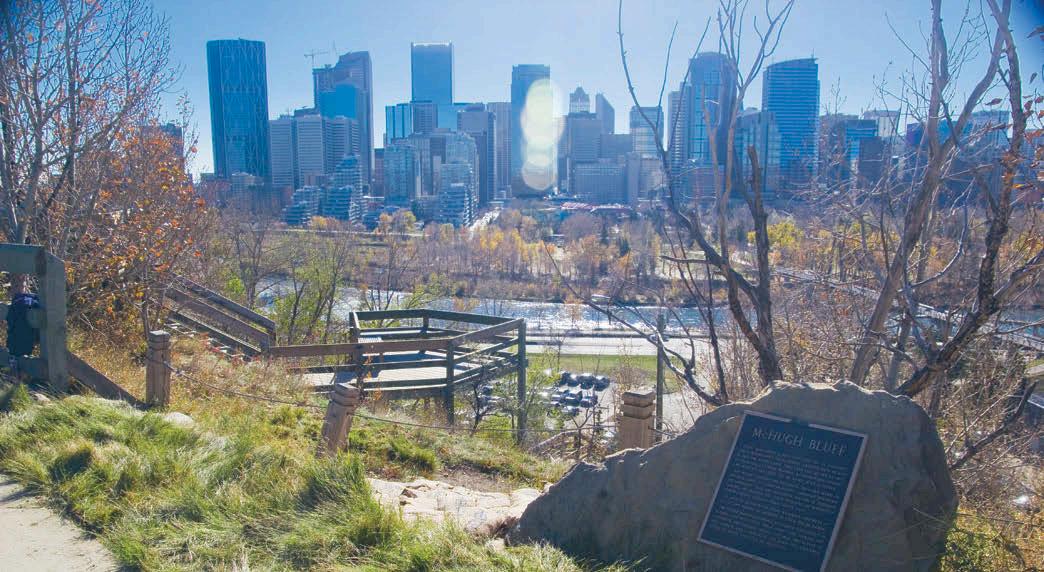
Because Eagle Lake’s NaturesTurf is grown as sod it provides immediate vegetation and erosion control once it is installed. Photo courtesy of Eagle Lake Landscape Supply
BioGrass Is Growing Their Alternative Product Market
Another innovator, and also a TPI past president, is Warren Bell, president of BioGrass® Sod Farms, Inc. in Sandy, Utah. According to Warren, the science behind BioGrass sod and seed products goes beyond beautiful surface characteristics to adaptation to climatic and other environmental conditions, including formulating waterefficient seed mixtures.
Warren works along with his son, Clark Bell, company general manager, and the rest of the BioGrass team, to apply the latest in turf science to develop specifically designed seed mixtures which incorporate a variety of species and cultivars to fill the varied uses of their broad customer base. The products are proprietary, often named for the functions they fill, such as BioShade or BioPlay, or the grasses they contain, such as BioBlue. For a complete listing, visit their website: www.biograss.com.
Utah’s current megadrought is escalating water use issues, an ongoing challenge in the state’s desert environment, reports Clark. “We don’t look at this situation as a threat, but rather as an opportunity to provide workable solutions for our customers. Our goal is to reduce our bluegrass acreage by 40 percent by focusing on desert-adapted alternatives to traditional lawn grasses that require less water and are low maintenance.”

BioNative is made up of wheat grasses, native to the intermountain west. Photo courtesy of BioGrass BioNative was developed to provide a grassscape aesthetic to fit nicely with the natural environment. It is quick to greenup in the spring. Photo courtesy of BioGrass As seen in this summer photo, BioNative can survive at a 4.5-inch height and only needs mowing once to twice a month to keep at that level. Photo courtesy of BioGrass
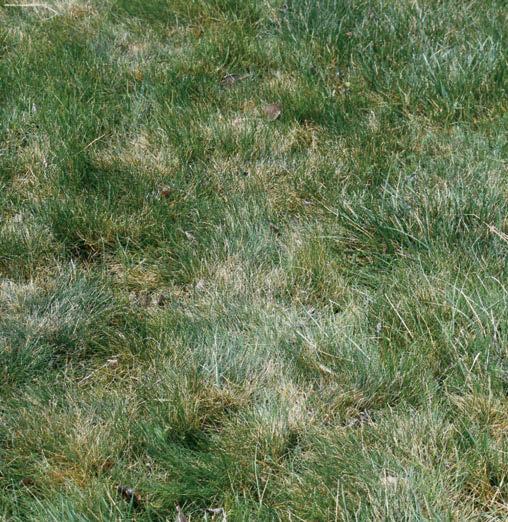
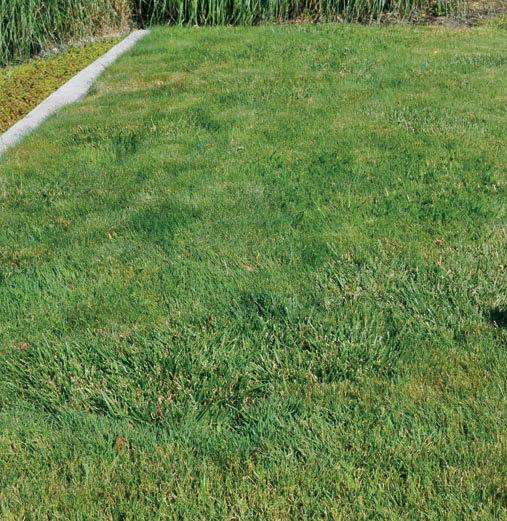

BioNative provides a pleasing aesthetic in the winter, as shown here peeking through the snow. Photo courtesy of BioGrass
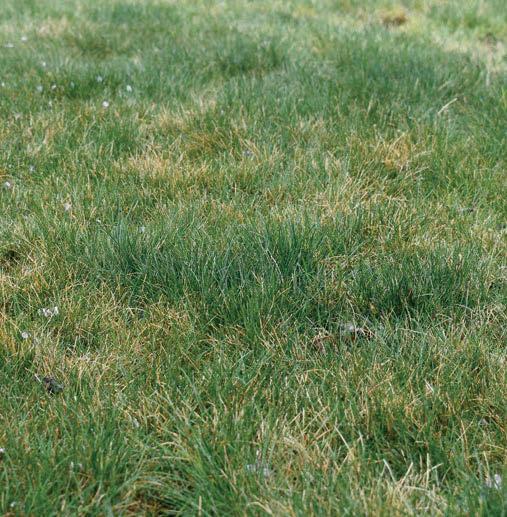
BioMeadow is quick to green up in the spring. Photo courtesy of BioGrass

BioMeadow retains good color into the fall, as this photo shows. Photo courtesy of BioGrass This photo shows BioNative in the fall. Photo courtesy of BioGrass


BioMeadow is composed of fine fescue varieties which stop vertical growth at a height between 6 and 9 inches, providing a soft aesthetic for no-mow sections of the landscape. Photo courtesy of BioGrass
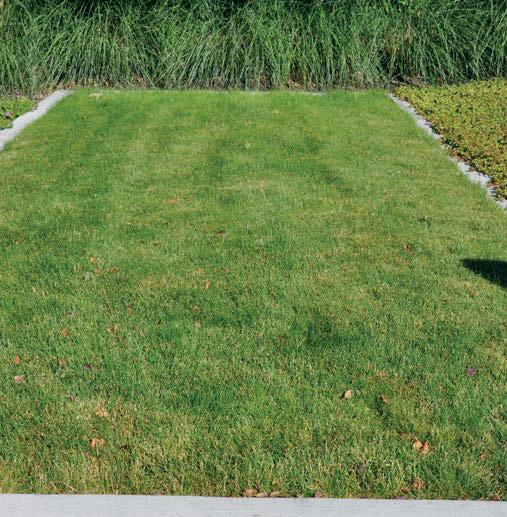
In the summer, BioMeadow looks as lush as a thick, green lawn, but with greatly reduced irrigation and maintenance needs. Photo courtesy of BioGrass
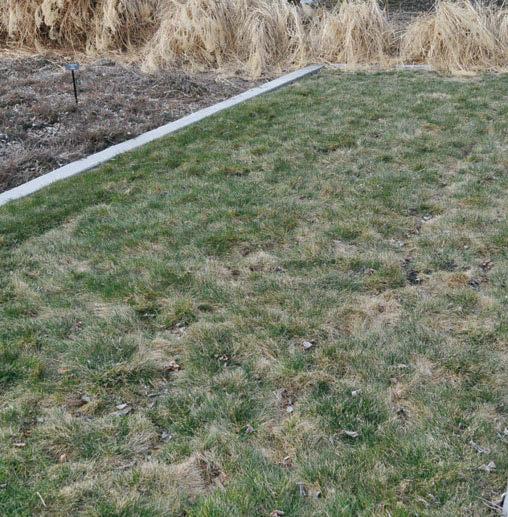
BioMeadow provides a pleasing aesthetic during the winter. Photo courtesy of BioGrass
One of their innovative alternatives is BioNative. It’s made up of wheat grasses, native to the intermountain west, and was developed for use where the client wants grassscape aesthetics to fit in nicely with the natural environment and with shrubs and a variety of non-woody perennial plants, including perennial flowers.
Clark says, “BioNative doesn’t provide a fine manicured lawn that you cut at 1.5 to 2.5 inches and it’s not a big recreation, heavy-use grass. The wheat grass can survive at a 4.5-inch height and only needs mowing once to twice a month to keep at that level.” Warren adds, “Landscape architects like to use it in the foothills of the mountains where, once it gets established, they only mow it in the fall and knock down the seed heads and clean it up a little bit. The architects love the seedheads, the height of the grasses, the early green-up in the spring, and how the look changes over the year.”
Interest and sales of BioNative are growing. Warren says, “We completely sold out of BioNative and had to turn down a 9-acre project, so we’re increasing our production to handle the demand.” Clark had a mid-August meeting with a large commercial group that had been using between 20,000 to 80,000 gallons of water on their lawns per month. He says, “These sites are around strip malls, a great fit for BioNative. It will cut their irrigation to 5,000 gallons per month and save on mowing costs, too.”
BioMeadow, their second alternative product also sold out for the year. It was developed for people who want a medium-height, no-mow mixture for a portion of their property; basically, a grass site that is not a cultivated lawn. Clark says, “It’s composed of fine fescues that stop vertical growth at a height between six and 9 inches. They have a soft aesthetic that looks as lush as a thick, green lawn, yet with greatly reduced irrigation and maintenance needs. BioMeadow is ideal for hillsides, and around gardens and cabins, or on commercial properties such as those in the Park City resort area. And like traditional lawn grasses, they sequester carbon and control soil erosion.”
Adapting Production and Installation
BioGrass grows both BioNative and BioMeadow as sod, so the customer doesn’t have to fight through the initial soil modification, seeding, and weeding. The customer irrigates and gets the sod established the first year it is down, and then shifts to the low maintenance program for the long term.
Clark says, “We’ve developed techniques that allow us to grow these products faster to accommodate the increased demand in this ‘up economy.’ That’s now six to seven and a half months, as compared to nine to twelve months for traditional grasses, but it does takes increased care. The type of seed, variabilities to germinate, senescence to growth—they all differ, much like the differences in growing bluegrasses and bentgrasses. There is more capital expense, but the payback is worth it.” Any bluegrass grower would have the wherewithal on their sod farm to develop similar, regionally adapted, alternative products, reports Warren. “We use the same planter, mower, and harvester, and similar inputs. We need to have our crop nutrition dialed in to produce these grasses. That fine tuning has helped us on the traditional turfgrass side, too. Using the right materials at the right time has enabled us to trim our budgets and made us better all the way around the farm.”
They report the toughest hurdle generally comes at harvest, not so much with the BioMeadow fine fescues, which don’t rhizome, but do knit together well. The BioNative wheat grasses may look like they’re ready to put on a pallet, but just like some bluegrasses, when tested, don’t come up well. Clark says, “Typically, we’ll use an application of Aqua-Yield NanoGro to promote knitting and give it a few more days before harvest.” These products need to be handled more gently during installation, cautions Warren. He says, “It usually requires about two and a half times longer to install than traditional lawn grass sod. Clark works with the contractors so they are aware they will have more labor hours involved during the installation and need to build that into the cost when they are bidding a project.”
Pricing it Right
As with most premium specialty products, BioMeadow and BioNative require more intensive care to establish, grow, and harvest—and that must be built into the cost of the product. Clark says, “We want to recoup our production costs and make a decent profit, but we don’t want these products to be too expensive to market successfully. We’ve found a 50 to 70 percent higher price upfront is acceptable to potential clients.” Warren adds, “Clark has done very well in setting the expectations for the property owner so they realize from a budgetary standpoint the upfront costs will be greater, but they’ll benefit over the long-term with reduced water needs and maintenance costs. It’s a fairly easy discussion to have.”
Continuing to Evolve
Warren reports these alternative products will continue to evolve with little changes over time in the plant materials and percentages. He says, “We’ll always be tweaking, exploring the NTEP introductions, watching marketplace trends, and using test plots on our land, with our soils and the winds of nature in our market area to develop products that are going to work well here. Landscape architects and designers appreciate having more tools to work with in natural plants that can the weather the challenges of water restrictions and contribute to environmental sustainability.”
Sodco, Inc. Continues as Conservation Innovators
Sodco, Inc. of Slocum, Rhode Island, has established a reputation as conservation innovators. The team of Dawson Hodgson, president, Pat Hogan sales manager, and John Eidson, farm manager, seek solutions to fill the needs of the ever-evolving marketplace and economic fluctuations. One of their innovative products was developed in response to a customer’s project for the New York City Parks Department to fit the requirements of the no fertilizer, no chemical, and limited water situation for Lindower Park in Brooklyn.
Eidson brought in some Microclover™ seed from DLF and blended it with Jonathan Green’s Black Beauty seed to plant two acres of what would become Sodco’s Microclover™ Black Beauty Blend (also known by the product name Players Best). Sodco’s website states, “Unlike 'white clover' or 'Dutch clover', Microclover will not colonize by spreading and growing only in patches. Microclover plants will remain small, individual, and evenly sprinkled throughout the grass to create a look that is beautiful and a lawn that is selfsustaining. The Microclover’s ability to fix nitrogen makes it “its own little fertilizer factory.”
Hogan says, “In September of 2015, the contractor installed 15,000 square feet of the Microclover sod in the park. In February of 2016, it passed the regulatory and compliance initiatives, and we were given authorization to talk about it. In 2016, we sold 42,000 square feet; in 2017, 120,000 square feet, and in 2018, we had 130,000 square feet sold with an 80,000 square foot job on the books for late fall.” Fast forward to 2021 and Hogan reports the product has been successful, with sales growing each year. He says, “We’re currently growing 90,000 square foot for an architect’s special project in addition to what we had already planted. We’ll be planting even more than what we’ve planted before to prepare for 2022 sales.”
Canada’s Groupe Richer Grows with Ecological Alternatives
Groupe Richer Inc. in Les Coteaux, Quebec, Canada, is a third-generation family business that thrives on innovation. Continuing to cultivate the passion of founder, Jean-Guy Richer, company president, Robert Richer, and his sons, Julien, as general manager, and Gabriel, as operations manager, ensure the family business’ continuity with a shared creative vision and contagious dynamism. As in many other places around the world, people in Quebec are increasingly aware of climate change and the need for environmental protection. In 2003, a new provincial law prohibiting many pesticides for aesthetic purposes shook the green space maintenance sector. Since then, some municipalities have banned the use of synthetic fertilizers, and some even organic fertilizers on their territory, in addition to having banned all pesticides. This new reality only confirmed the thinking and initiatives of Groupe Richer, and the third generation has begun to offer more eco-friendly products. They have introduced a Microclover®-boosted low-maintenance turf under the name Eco-Turf.
The logical next step for Gabriel and Julien was to explore producing turf organically. After several years of trial and error, Groupe Richer’s first organically grown sod was launched in September 2020. Two organic varieties are available, a lowmaintenance turf consisting of Kentucky Bluegrass, Creeping Red Fescue, Chewing Fescue, and Hard Fescue; and a biodiversity turf grown in an old elk pasture, which includes pasture grass species and native plants and wildflowers. Organic agricultural management prohibits the use of pesticides and chemical fertilizers for a minimum of three years on all the parcels of land used. Moreover, soil conservation and regeneration practices are used. The experience acquired with its organic turf adventure has also helped Groupe Richer refine its sustainable agriculture practices on all its acreage and to undertake further research and development of alternative products.
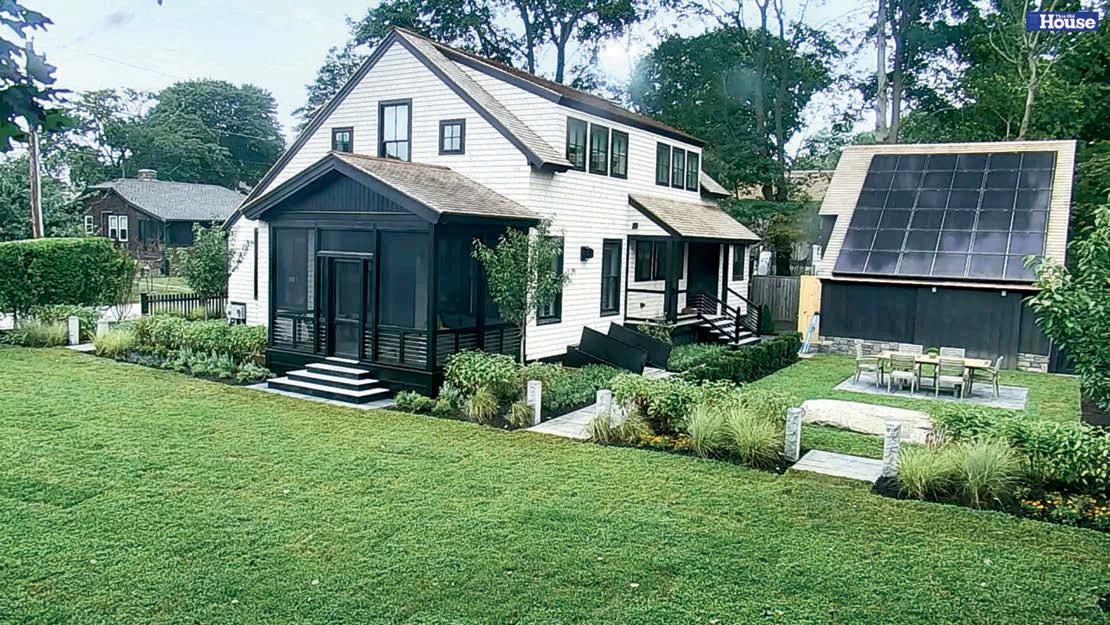
Sodco installed Microclover™ Black Beauty Blend in the outdoor gathering place of the This Old House “Net Zero” project in Jamestown. Photo courtesy of Sodco
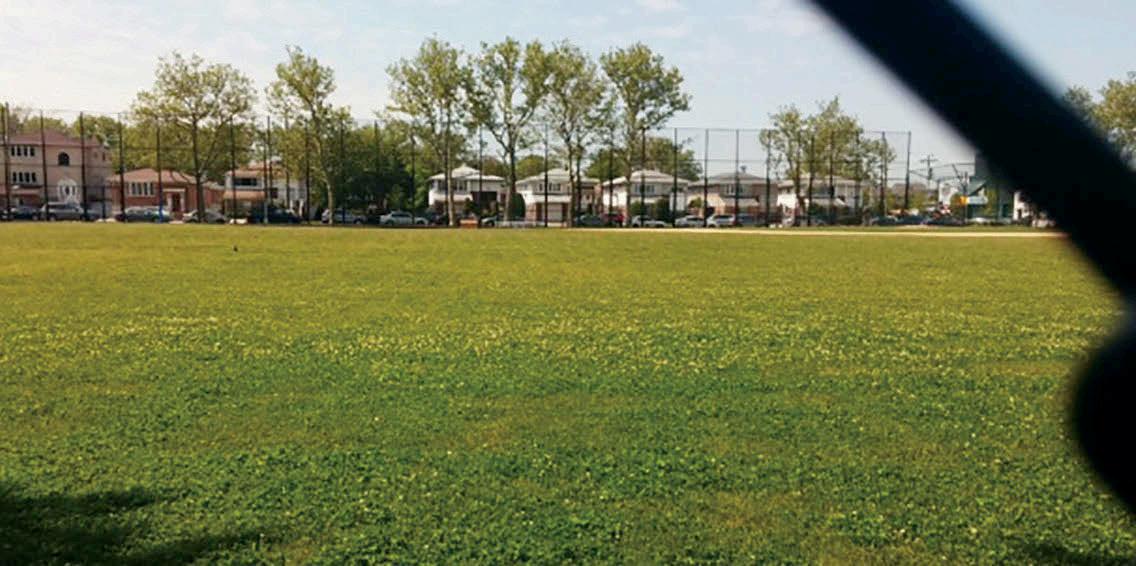
At a friend’s request, Sodco Farm Manager John Eidson developed a selfsustaining product, Microclover™ Black Beauty Blend, to be installed at Lindower Park in Brooklyn, NY. Photo courtesy of Sodco
Special thanks go to Marie-Claude Darveau, company agronomist and sod farm manager, and Michele de Repentigny, company marketing specialist, for telling the Groupe Richer story.
Groupe Richer Announces Two New Alternative Products in Research and Development
On July 22, 2021, Groupe Richer issued an email to its customers and potential customers seeking test plots in “real world” situations for two new alternative products currently in their research and development program. That document opened with this question, “Did you know that for more than ten years Groupe Richer has been developing, with enthusiasm and environmental awareness, more ecological turf varieties? We are currently working on a very interesting project: to offer flowered turf and flowered meadow for 2023! We are also looking for test plots (residential, commercial, or municipal) to continue our research and development. We have limited quantities available. If you are interested in this trial project, please contact Stephane Pigeon.”
The first product, Flowered Grass, is a variety made up of grass and wildflowers designed to keep shorter, maintaining it at a height of approximately six inches by mowing it once a month. It has been developed for use in residential properties, parks, rest areas, public squares, cemeteries, and similar sites.
The second product, Flowered Meadow, is a variety made up of grass and wildflowers that is designed for minimal maintenance to allow the flowers to grow and bloom according to their normal cycles. It will require only one mowing per season. It has been developed for use in islands of biodiversity, in site re-naturalizations, on embankments, at the edges of cycle paths, around retention ponds, and on maintenance free, no mowing, long grass areas on golf courses, on small hills, ditches, the edges of unmaintained woodlands, and similar sites.
The email further stated what the company had learned from its ongoing discussions with landscape architects: they wanted this aesthetic in their projects but found developing them on a site too challenging to be successful. “Many people in the industry try to achieve a similar result for islands of biodiversity or similar uses in municipal settings. The two major problems seem to be competition from weeds (the time and costs associated with manual weeding, especially during the first years of establishment) and the fact that the flowers must be reseeded every year or else wait three to four years to potentially have an interesting result. Therefore, we think we can fill a need with our flowered lawns in rolls: the perennials are already established, and the grass limits the establishment of weeds.”
Pigeon reports, “I received many responses the same day the email went out, including one from a landscape architect in Montreal that came so quickly it seemed like he had composed his reply earlier and was just waiting for the email to arrive. It was encouraging to see our request for testing sites so well received.”
The company has been striving to make the world a more ecologically friendly environment the past 60 years and these new products are part of that process. Pigeon says, “Both of these alternative products have been thriving in our testing fields.” He reported on a recent visit to one of the company’s flowered grass fields which was six-inches tall. “The grasses were intermixed with blooming flowers, and it looked and smelled lovely. Different sections of the field were showing different percentages of flowers reflecting the variety within the plantings and their response to the microclimates of each area. The field was chock full of butterflies and other pollinating insects, many more than I’ve observed in our other sod fields. These insects will attract more birds, creating more of a habitat than the typical sod farm field. We anticipate the same thing will happen for our customers and are seeking the additional testing sites to see whether it will respond as well in commercial uses.”
Research and development are ongoing for Groupe Richer. Pigeon reports that all the company’s varieties are “tweaked every year. If the Turfgrass Water Conservation Alliance (TWCA) announces a new cultivar, we’ll consider putting that into some of our field testing. We’ve used the same process in developing our two new products. Our agronomic team works to achieve the vision of a desired product through plant selection and in-field testing, committing

Groupe Richer’s Flowered Grass is made up of grass and wildflowers. It was developed to maintain a height of approximately six inches by mowing it just once a month.

Groupe Richer’s Flowered Meadow is a mix of grass and wildflowers that was designed for minimal maintenance to allow the flowers to grow and bloom according to their normal cycle. It requires only one mowing per season. Photos courtesy of Groupe Richer
the resources needed through what can be a long and tedious process. When they determine a product is ready to introduce, even though we’re professionals, it can still take us two years to grow it until it’s ready for harvest.”
With the flowering grass, the sod grows for a year with just the grasses. The second year, the annuals are seeded in to establish, bloom, and seed between the less frequent mowings. Pigeon says, “Our crews do whatever hand weeding is needed to still stay ahead of any weeds that pop up during that second season. By the third year, when the flowered grass is mature and ready for harvest, the annual flowers are able to effectively reseed themselves. It also takes approximately two years for the flowering meadow to reach maturity. By the third year, the perennials will be repeat growers and bloomers.”
Matching the Product to Site Needs
The product is the key part of the company’s ecological outreach, but also essential is matching the product to site needs. Most customers ordering sod online will select one of the company’s traditional bluegrass products because it looks like the lawns they are most accustomed to, Pigeon reports. With those that call in to order, the sales team can ask questions about how the customer wants to use the area to help them make the best product match. “It’s a bit like ordering in a coffee shop,” says Pigeon. “We have much to
Pricing and Profits
With more extensive production costs involved, the pricing for these two new products will need to be greater than that of traditional lawn grasses. Pigeon says, “These products have been developed for a niche market. The price may need to be as much as 200 percent that of sod composed of traditional lawn grasses. Yet the value is worth the price. We’re not going to question who has the budget for one of these specialty grasses. We just want to put these choices out there, explain why they are beneficial, and let the customers do the value to cost evaluation and make their own decisions.”
He points out that prices of most products have increased due to the impact of Covid-19, so people in 2021 are already expecting to pay more for things. The price of standard turfgrass sod has gone up which seems to prompt customers to be more willing to look at the specific varieties. With the pesticide and fertilizer bans, many people have issues with maintenance and are more open to considering other options.
So, what potential sod alternatives will you explore?
Suz Trusty is co-editor of Turf News.
Look Who’s Growing Black Beauty and Blue Panther
Black Beauty Sod at Fricke & Sons Sod Inc., Maple Grove, MN.

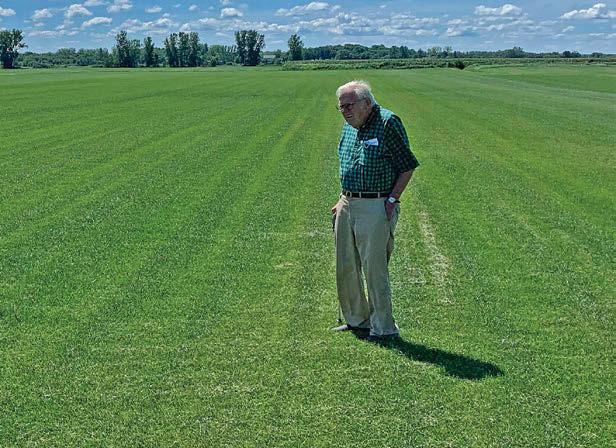

One misconception about tall fescue is that it does not overwinter well during long, cold winters. While this may have been true for early varieties of tall fescue, Black Beauty Tall Fescue has proven itself in one of the snowiest states in the country, Minnesota, as proven by Fricke & Sons Sod. Brothers Steve and Terry Fricke have been growing Black Beauty and Blue Panther for the past few years and seeing incredible results. Fricke & Sons Sod is in Maple Grove, MN, where weather conditions can be extreme in winter or summer. Currently the St. Paul-Minneapolis area is experiencing high temperatures with little to no rainfall, which Kentucky Bluegrass. This is an area where Black Beauty shines. It’s natural heat and drought tolerance comes from its four-footdeep root system and waxy leaf coating, making Black Beauty a
Barry Green Sr. standing in Fricke & Sons’ field of Blue Panther Kentucky Bluegrass.
PROFESSIONAL TURF PRODUCTS PROFESSIONAL SOD DIVISION
SUPERIOR GRASS SEED PRODUCTS
Michael Vanden Bosch: 732-804-1743 / mvande@jonathangreen.com Barry Green II: 908-217-0818 / 800-526-2303 x202 / bgreenii@jonathangreen.com David Bradley: 828-606-7186 / dbradley@jonathangreen.com










